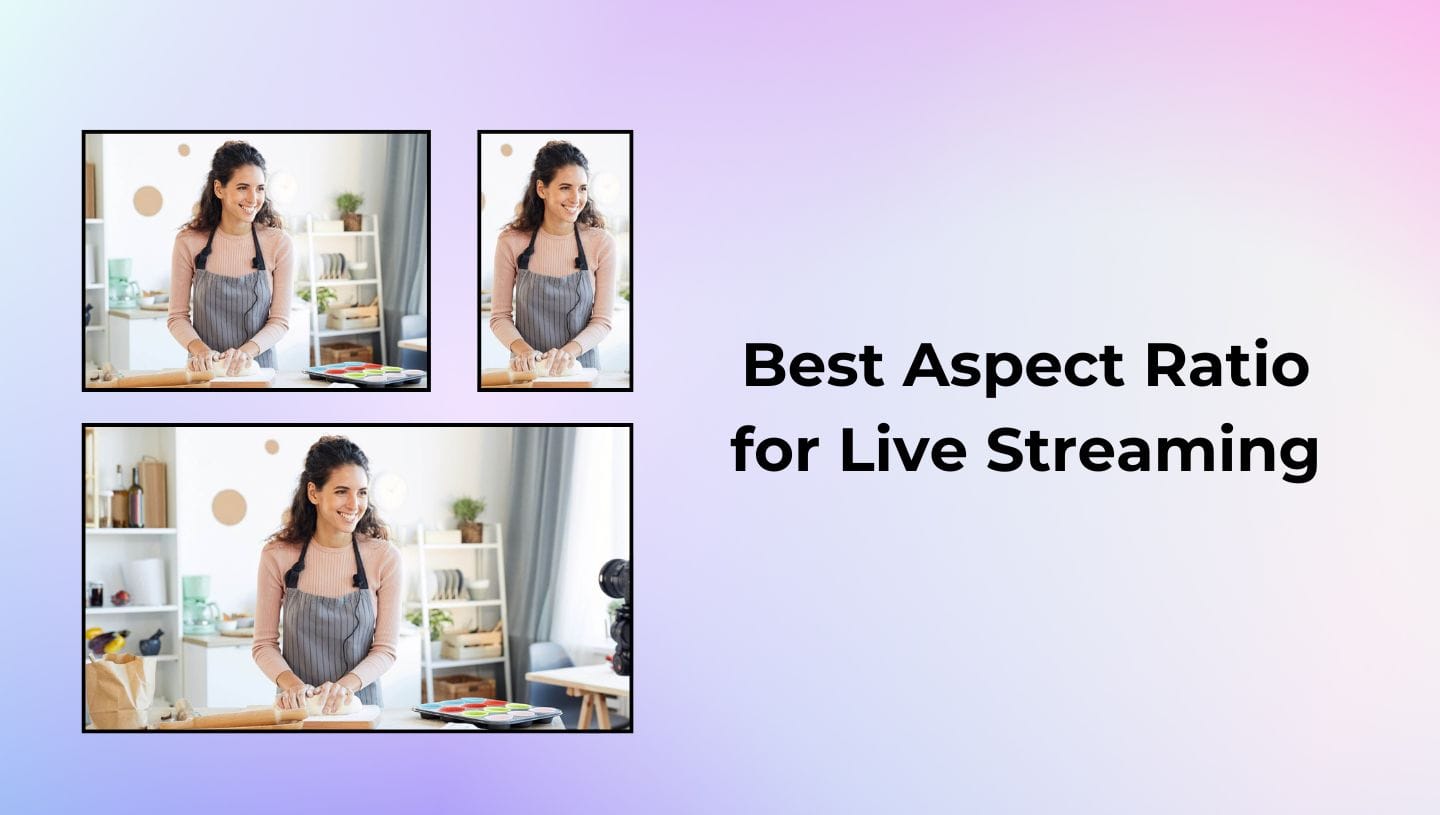Best Aspect Ratio for Streaming: Improving Viewer Experience

Whether you're a seasoned live streamer, a budding content creator, or a savvy social media manager, you've likely encountered the curious puzzle of aspect ratios. What's the big deal, you ask? Well, those dimensions on your screen - like a director's cut or a widescreen blockbuster - can shape how your audience experiences your content. Let's chat about these different slices of the streaming pie 🥧
The Most Common Aspect Ratios
- 16:9: The mainstream choice for high-definition content, seen on YouTube, modern TVs, and most streaming platforms.
- 9:16: The vertical favorite, ruling mobile-first platforms like Instagram Live and TikTok.
- 4:3: The classic square-ish format, typical in older television broadcasts and offers a touch of nostalgia.
- 1:1: Used primarily for social media platforms like Instagram posts, delivering symmetry with every square.
- 21:9: Offers a cinematic, ultra-wide experience, though less common in the average streaming setup.
- 18:9: Also known as 2:1, this ratio is common in new smartphones, providing a slightly taller view than 16:9.
- 2.35:1/2.39:1: Widely used in the film industry for its cinematic presentation, generating a truly panoramic view.
- 3:2: Popular in photography and some tablets, it strikes a nice balance between the elongated 16:9 and the traditional 4:3.
Each of these ratios brings its own flavor and functionality, offering unique experiences based on the device or platform. With such a buffet, choosing the right one can elevate your content to a whole new level, creating an engaging experience tailored to your audience.
The Big Three: 16:9, 9:16, and 4:3 Ratio
16:9 Ratio - The Cinematic Darling
The common 16:9. This familiar favorite of digital screens is as familiar to us as popcorn at a movie theater. But why does everyone love it so much? It's not just because it looks good - though that helps. This aspect ratio is the go-to format for high-definition broadcasts, YouTube videos, and most web content. We've seen its elegance grace everything from epic gaming streams to detailed tutorials.

Pros:
- Widespread Compatibility: Optimal for platforms like YouTube and Twitch where most viewers consume content on widescreen displays.
- Professional Quality: Provides a polished look, ideal for gaming channel streams, webinars, and professional presentations.
Cons:
- Less Mobile-Friendly: Requires viewers to rotate their phones or squint at smaller text in a live stream when viewed vertically.
- Not Suited for Vertical Platforms: Doesn't take full advantage of mobile-focused platforms like TikTok.
Imagine stepping into a cozy theater where the screen stretches luxuriously wide, offering a breathtaking view that sweeps you off your feet. That's 16:9 for you! It offers a cinematic experience that fits most modern TVs and computer monitors like a glove. Your viewers get all the action, no awkward letterboxing to distract them.
4:3 Ratio The Nostalgic Classic
Ah, 4:3 - how you've aged like a fine wine (or perhaps a beloved VHS tape?). Kidding aside, this traditional format stirs up nostalgia for those who remember tube TVs and early computer monitors. Once the standard, it's not your first go-to anymore, but it's beloved in niche circles.

Pros:
- Great for Niche Audiences: If your content has a retro theme, like classic video game streams, this format fits perfectly.
- Simpler Equipment: Some older streaming setups and cameras default to this ratio, making use simpler without conversion.
Cons:
- Outdated for Most Modern Content: Viewers on widescreen monitors might see black bars or feel the content looks dated.
- Limited by Audience Expectation: Less appealing to users who favor high-definition, widescreen formats.
If you're archiving old content or stepping into the world of vintage gaming, 4:3 is your buddy. It's the cozy sweater of aspect ratios - familiar, comfortable, and delightfully retro. You could say it's not just déjà vu; it’s a whole genre.
Comparing 16:9 Ratio vs 4:3 Ratio 🥊
When it comes to comparing 16:9 and 43 offer quite distinct viewing experiences.


16:9 Ratio vs 4:3 Ratio Comparison
The 16:9 ratio, with its wide, rectangular view, is a staple in the live streaming world. It mirrors the broad, cinematic scope of a movie theater screen, making it ideal for capturing extensive scenes and delivering a visually rich experience. This aspect ratio fits beautifully with widescreen TVs and most streaming setups, aligning with modern viewers’ expectations for HD content in gaming streams, professional broadcasts, and live events. Its horizontal spread allows streamers to include more visual content, whether that’s gameplay, presentation slides, or scenic backgrounds, ensuring a fully immersive viewer experience.
In contrast, the 4:3 ratio presents a more square-like frame, resembling the dimensions of classic television screens and early computer monitors. This aspect ratio, being slightly taller than it is wide, brings a distinct, nostalgic charm. It's often used for streaming retro content, like vintage video game playthroughs or archival footage, where the aim is to recreate the original viewing experience that older media formats offered. The 4:3 ratio evokes a sense of nostalgia, appealing to audiences who appreciate the classic look and feel of vintage broadcasts.
9:16 Ratio - The Mobile Maestro
Now, let's flip that screen and talk about 9:16. Being vertical might sound strange if you're used to the old-school horizontal formats, but there's a reason it's the reigning champion on mobile devices. Think Instagram Stories, TikTok clips, or those snappy live streams—9:16 fits snugly into every millennial's hand.

Pros:
- Perfect for Mobile Audiences: Matches the typical way audiences hold their phones during social media streams.
- High Engagement Potential: Popular for interactive, quick, and personal streams on platforms like Instagram Live.
Cons:
- Challenging on Desktop or TV: Content can appear awkward with significant empty space on the sides.
- Platform Limitations: Not all live streaming platforms support vertical video effectively.
Ultimately, the "right" aspect ratio for streaming depends on your platform and target audience. As a content creator, you have the power to craft an immersive viewing experience. The perfect slice of that streaming pie allows your vision to take center stage - capturing the exact vibe you want to share with your audience.
Which Ratio to Choose for Streaming?
Sure, standard guidelines tell us that 16:9 is the king where high-quality and professional content streams live. However, this choice isn't always black and white. Embracing different aspect ratios can elevate your content in surprising ways.
You probably weren't expecting to think so much about screen dimensions, right? But you're not alone. Creators everywhere are abuzz about how small tweaks can make a huge difference.
Wrapping Up
In the evolving landscape of content creation, understanding aspect ratios is more than just a technical detail - it's a way to shape your audience's experience. Whether you're opting for the widely-acclaimed 16:9 for a cinematic view, the nostalgic charm of 4:3, or the vertical engagement of 9:16, each choice reflects the story you wish to tell.
16:9 brings a modern, expansive feel, perfect for capturing breathtaking scenes and fitting seamlessly on most screens. Meanwhile, 4:3 takes us back in time, offering a cozy, retro vibe that evokes nostalgia. For those mobile moments, 9:16 reigns supreme, fitting right into the palm of your audience's hand.
Ultimately, the "right" aspect ratio depends on your platform and desired audience experience. As a creator, you're painting on the canvas of your screen, with each ratio offering a unique frame for your masterpiece. So go ahead, experiment, and let your content shine in its ideal form. Who knows? The perfect slice of that streaming pie could just be the one you create yourself.
Transform Your Live Streams with LiveReacting
Join 10,000+ streamers who are boosting engagement and viewership by adding pre-recorded videos, games, polls, and countdowns to their streams.
Try LiveReacting for free today and take your streams to the next level!
